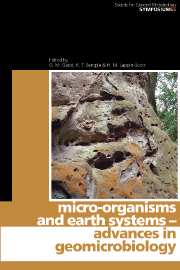Book contents
- Frontmatter
- Contents
- Contributors
- Editors' Preface
- Isotopic-labelling methods for deciphering the function of uncultured micro-organisms
- Biofilms and metal geochemistry: the relevance of micro-organism-induced geochemical transformations
- Minerals, mats, pearls and veils: themes and variations in giant sulfur bacteria
- Soil micro-organisms in Antarctic dry valleys: resource supply and utilization
- New insights into bacterial cell-wall structure and physico-chemistry: implications for interactions with metal ions and minerals
- Horizontal gene transfer of metal homeostasis genes and its role in microbial communities of the deep terrestrial subsurface
- Biosilicification: the role of cyanobacteria in silica sinter deposition
- Metabolic diversity in the microbial world: relevance to exobiology
- Biogeochemical cycling in polar, temperate and tropical coastal zones: similarities and differences
- Fungal roles and function in rock, mineral and soil transformations
- The deep intraterrestrial biosphere
- Iron, nitrogen, phosphorus and zinc cycling and consequences for primary productivity in the oceans
- Mechanisms and environmental impact of microbial metal reduction
- New insights into the physiology and regulation of the anaerobic oxidation of methane
- Biogeochemical roles of fungi in marine and estuarine habitats
- Role of micro-organisms in karstification
- Index
New insights into bacterial cell-wall structure and physico-chemistry: implications for interactions with metal ions and minerals
Published online by Cambridge University Press: 06 July 2010
- Frontmatter
- Contents
- Contributors
- Editors' Preface
- Isotopic-labelling methods for deciphering the function of uncultured micro-organisms
- Biofilms and metal geochemistry: the relevance of micro-organism-induced geochemical transformations
- Minerals, mats, pearls and veils: themes and variations in giant sulfur bacteria
- Soil micro-organisms in Antarctic dry valleys: resource supply and utilization
- New insights into bacterial cell-wall structure and physico-chemistry: implications for interactions with metal ions and minerals
- Horizontal gene transfer of metal homeostasis genes and its role in microbial communities of the deep terrestrial subsurface
- Biosilicification: the role of cyanobacteria in silica sinter deposition
- Metabolic diversity in the microbial world: relevance to exobiology
- Biogeochemical cycling in polar, temperate and tropical coastal zones: similarities and differences
- Fungal roles and function in rock, mineral and soil transformations
- The deep intraterrestrial biosphere
- Iron, nitrogen, phosphorus and zinc cycling and consequences for primary productivity in the oceans
- Mechanisms and environmental impact of microbial metal reduction
- New insights into the physiology and regulation of the anaerobic oxidation of methane
- Biogeochemical roles of fungi in marine and estuarine habitats
- Role of micro-organisms in karstification
- Index
Summary
INTRODUCTION
Prokaryotes are the Earth's smallest life form and, yet, have the largest surface area : volume ratio of all cells (Beveridge, 1988, 1989a). They are also the most ancient form of life and have persisted on Earth for at least 3.6 × 109 years, even in some of the most extreme environments imaginable, such as the deep subsurface. Most of these early primitive (and today's modern) natural environments possess reasonably high amounts of metal ions that are capable of precipitation under suitable pH or redox conditions. Deep-seated in such geochemical situations is the likelihood of suitable interfaces that lower the local free energy, so that interfacial metal precipitation is promoted. Bacteria, being minute and having highly reactive surfaces (interfaces), are exquisitely efficient environmental particles for metal-ion adsorption and mineral nucleation. Metal ions interact with available reactive groups (or ligands) on the bacterial surface and precipitates grow as environmental counter-ions interact with more and more metal at the site (Beveridge & Murray, 1976, 1980; Beveridge et al., 1982; Ferris & Beveridge, 1986; Fortin et al., 1998). Once formed, these precipitates are under the influence of natural geochemical and additional microbially mediated conditions (Lee & Beveridge, 2001) that instigate the development of fine-grain minerals, usually via dehydration, so that crystalline phases are eventually developed (Beveridge et al., 1983). These minerals commence as so-called ‘nano-mineral phases’ and grow with time to become larger and larger.
- Type
- Chapter
- Information
- Micro-organisms and Earth Systems , pp. 85 - 108Publisher: Cambridge University PressPrint publication year: 2005
- 2
- Cited by

